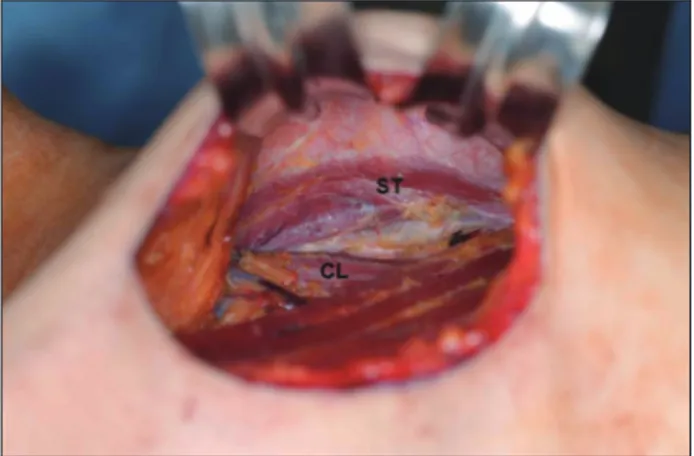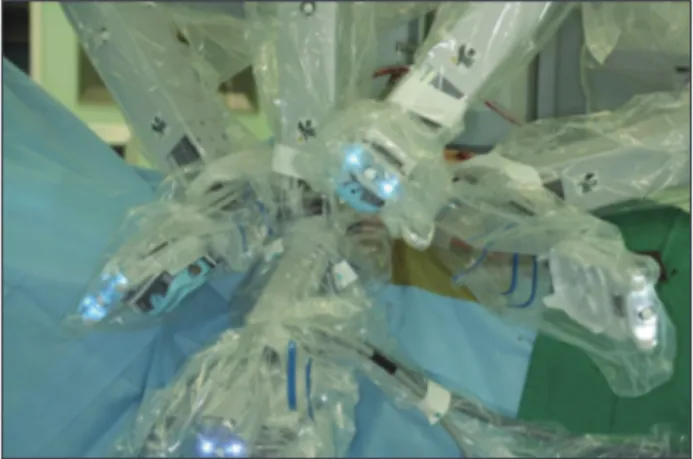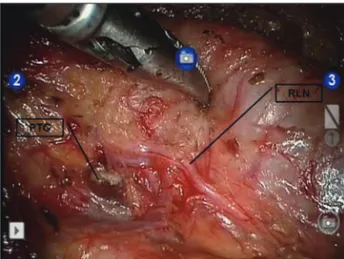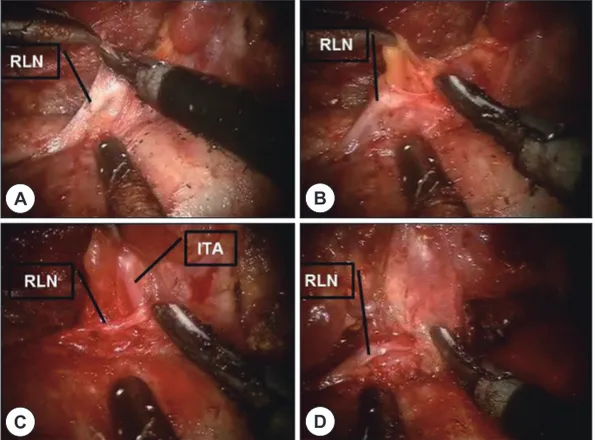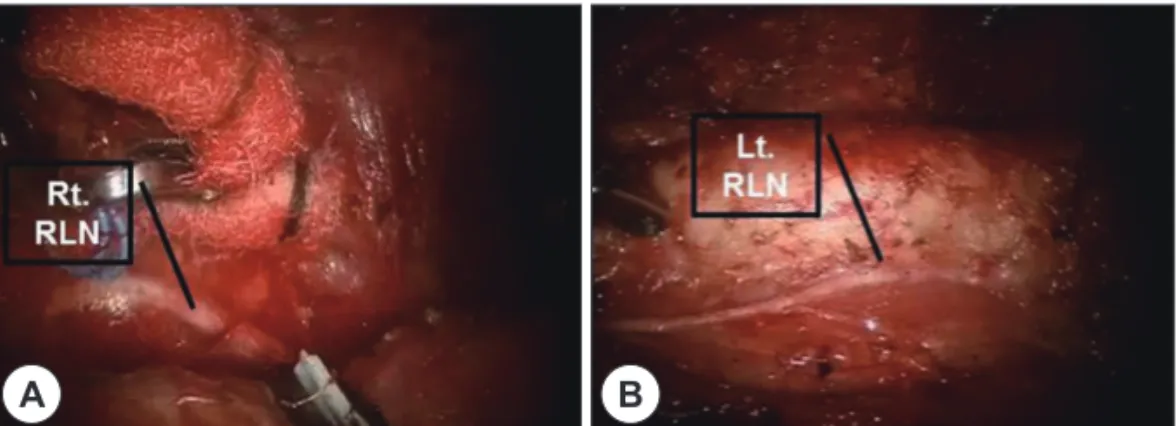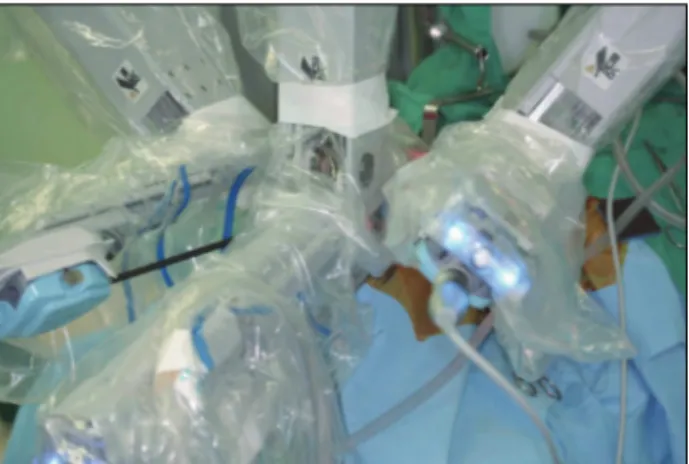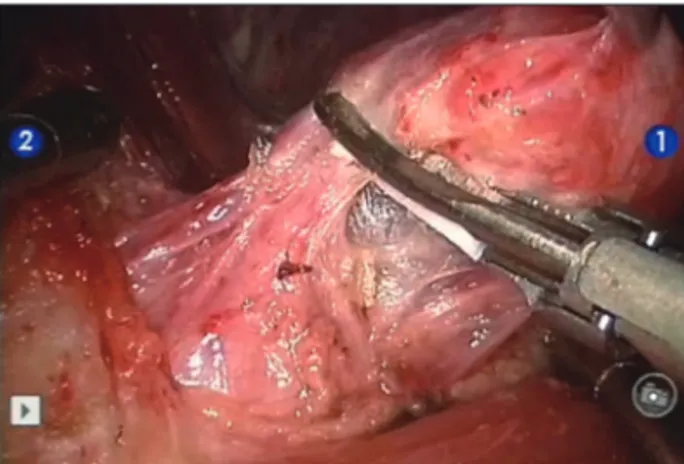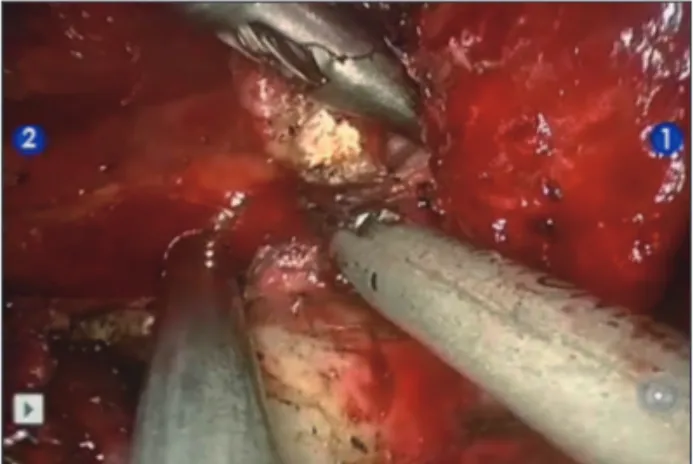서 론
기존의 갑상선절제술은 피부주름을 따라 경부절개선 을 통하여 시행되어 왔고 경부 림프절 전이로 경부절제 술이 필요한 경우에는 보다 긴 절개선이 요구되기도 한다.
대부분의 경우 갑상선절제술을 위한 고식적인 절개선 은 시간이 흐를수록 크게 눈에 띄지 않고 미용적으로 크 게 문제가 되지 않지만 경우에 따라서는 비후성 반흔 혹 은 켈로이드 등의 흉터를 남기기도 한다. 최근 갑상선 결 절, 특히 미세유두상암종(micropapillary carcinoma)의 발생 빈도가 증가하고 특히 여성에서 현저히 그 빈도가 높은 실정에서 수술에 의한 반흔을 최소화하기 위한 다 양한 시도들이 이루어져 왔다.1) 즉, 최소침습수술(min- imally invasive surgery) 개념이 도입된 이후로 전 세계적 으로, 특히 국내를 비롯한 아시아를 중심으로 내시경과 로봇 시스템을 이용한 다양한 원격 접근 갑상선수술(re- mote access thyroid surgery) 등이 보고되고 있다.2-14) 특히, 로봇 수술 시스템의 발달과 더불어 갑상선절제술 후의 흉터를 없애기 위한 시도에는 가속도가 붙게 되었 다. 이 중 국내의 정 등이 개발한 액와접근법을 이용한 로 봇 갑상선절제술(robotic thyroidectomy via transaxillary approach)이 가장 널리 보급되어 전 세계적으로 이용되
고 있는 술식이며15-19) 그외 윤 등이 개발한 Bilateral ax- illo-breast approach(BABA) 등과 여러 변형된 접근법을 이용한 술식이 보고되고 있다.20,21) 최근 미국의 Terris 등 은 액와부 접근법을 이용한 로봇 갑상선절제술이 가지는 몇가지 단점들을 보완하기 위하여 변형적 안면거상접근 법(modified facelift approach)을 이용한 로봇 갑상선절 제술의 술식을 보고하면서 동양인에 비해서 체구가 큰 서양인에서 보다 안전한 원격 접근 갑상선수술(remote access thyroid surgery)로서의 가능성을 보고하였다.22-25) 본 저자의 경우 2010년부터 액와접근법을 이용한 로봇 갑 상선절제술을 시행하여 약 200예 이상의 경험을 쌓았으 며 2013년부터는 변형적 안면접근법 즉, 후이개접근법 (retroauricular approach)을 이용한 로봇 갑상선절제술 을 시행하고 있다.
이에 본 저자가 경험한 두가지의 전혀 다른 접근법인 액와부 접근법과 후이개접근법의 술식에 대해서 자세히 언급하고 수술의 안전성과 침습성, 수술 시간, 합병증, 갑상선전절제술의 가능성 등을 토대로 한 두 술식간의 장 단점에 대해서 논의해보고자 한다.
로봇 갑상선 절제술을 위한 기구 (Instrumentations)
피판 거상을 위한 견인기(Retractors to elevate the skin flap)
- Skin hook
갑상선유두암 수술의 이해-로봇 갑상선 수술
연세대학교 의과대학 이비인후과학교실
고 윤 우
Controversy of the Surgery of Papillary Thyroid Cancer-Robotic Thyroidectomy
Yoon Woo Koh, MD, PhD
Department of Otorhinolaryngology, Yonsei University College of Medicine, Seoul, Korea
교신저자 :고윤우, 120-752 서울 서대문구 성산로 250 연세대학교 의과대학 이비인후과학교실
전화 :(02) 2228-3607・전송:(02) 393-0580 E-mail:ywkohent@yuhs.ac
- Army-Navy retractor - Right-angle ‘breast’ retractor
- Self-retaining retractor(Sejong Medical Corpora- tion, Gyohaeup, Korea)(Fig. 1A)
로봇 수술 시스템[Robotic instruments(Da Vinci Robotic System- Intuitive Surgical Inc., Sunnyvale, CA)]
- 30 degree face-down dual-channel endoscope (Intuitive Surgical Inc., Sunnyvale, CA)
- 5 mm Maryland forceps(Intuitive Surgical Inc., Sunnyvale, CA)
- Harmonic curved shears(Intuitive Surgical Inc., Sunnyvale, CA)
- ProGrasp forceps(Intuitive Surgical Inc., Sunnyvale, CA)
기타 수술을 위해 필요한 기구(Other instruments to facilitate surgical process)
- Bovie tip(electrocautery tip) : conventional size of spatula type and also additional tips which progres- sively lengthens.
- Hemoclip or Hem-o-lockⓇ : for ligating uncon- trollable vessels such as branches of the internal jugular vein.
- Yankauer suction(Fig. 1B)
로봇 갑상선절제술의 적응증과 금기증
수술의 적응증
1) 수술이 필요한 약 6 cm 미만의 양성 결절, 2) 수술 이 필요한 6 cm 미만의 Bethesda 분류 category IV 여포 종양 신생물, 3) 술 전 초음파검사상 2 cm 미만의 갑상 선엽내에 국한된 경우 분화성 갑상선암
수술의 금기증
1) 술 전 초음파, 전산화 단층촬영, 혹은 자기공명영상 상 기관식도구에 인접하여 동측 반회후두신경(recurrent laryngeal nerve) 손상 가능성이 있는 경우, 2) 술 전 초음 파, 전산화단층촬영, 혹은 자기공명영상 상 심한 국소 침습이나 갑상선 피막외 침습이 의심되는 경우, 3) 심한 갑상선염이 있거나 괴거력 상 경부수술 혹은 방사선조사 등의 기왕력이 있는 경우(상대적 금기증), 4) 재발한 갑상 선암
수 술 술 기
액와접근법을 이용한 로봇 갑상선절제술(Robotic thyroidectomy via transaxillary approach)
전신 마취 상태에서 환자는 앙와위로 경부를 약간 신전 시킨 상태에서 환측의 상지를 거상하여 환측의 액와부 를 완전히 노출시킨 후 상지를 고정시킨다. 이때 장시간 상지 거상으로 인한 일시적인 상완신경총 신경손상(bra-
Fig. 1. Self-retaining retractors and new designed Yankauer suction. A : The two retractors on the left are the former Chung’s retractors for endoscopic or robotic thyroid operations and the four retractors on the right are modified re- tractors for neck dissections via retroauricular or modified facelift approach. B : New designed Yankauer suction (top) modified from the conventional Yankauer suction (bottom).
A B
chial plexus neuropathy)을 예방하기 위해 최대한 상완 신경총이 긴장 혹은 신전되지 않도록 편안한 자세에서 상지를 고정시켜야 한다(Fig. 2).
액와부에 30° face down dual channel endoscope 과 로봇 기구의 삽입을 위한 약 5~6 cm의 피부주름과 평행 하게 피부절개를 도안한다. Bovie coagulator를 이용하 여 대흉근(pectoralis major muscle)의 천층을 통해 흉쇄 유돌근(sternocleidomastoid muscle)의 전연까지 광경 근하 피부피판(subplatysmal flap)을 거상한다(Fig. 3).
흉쇄유돌근의 전연이 노출되면 이 근육의 sternal head 와 clavicular head 사이의 공간을 확인하고 박리하여 갑 상선을 싸고 있는 피대근을 노출시킨다(Fig. 4). 이때 내 경정맥과 경동맥의 손상에 유의하며 흉골설골근(ster- nohyoid muscle)과 흉골갑상근(sternothyroid muscle) 을 내측으로 견인하여 병변측 갑상선을 노출시킨다. 이때
가능한 견갑설골근(omohyoid muscle)은 절제하지 않고 위로 거상시킨다(Fig. 5).
수술 시야를 확보하기 위해 액와부의 피부 절개를 통해 외부견인기(Sejong Medical Corporation, Gyoha-eup, Korea)를 삽입하고 이를 거상기에 연결하여 피판과 피대 근을 거상시킨다(Fig. 6). 로봇 갑상선 전절제술을 위해 서 병변측 유륜과 피부경계부위에 1.0 cm 피부절개를 하 여, 흉골 절흔(sternal notch) 중심부 방향으로 ProGrasp forceps 삽입을 위한 공간을 확보하기도 한다(Fig. 7).
30° face down dual channel endoscope를 로봇 시스 템의 중앙팔에 거치시키고 액와부의 피부절개를 통하 여 중앙에 위치시킨다. 그 외 Harmonic curved shear와 Maryland forceps은 각각 내시경의 양측에 위치시킨다.
Fig. 2. Position of the patient and design of the skin incision.
The neck is slightly extended, and the patient’s lesion- side arm is raised to expose the axilla.
Fig. 3. Skin flap elevation and acquirement of working space.
Fig. 5. The thyroid gland is exposed by medial traction of the sternothyroid muscle (ST) and lateral traction of the sternocleidomastoid muscle. OH : omohyoid muscle, IJV : internal jugular vein, TG : thyroid gland.
Fig. 4. Once the sternocleidomastoid muscle is outlined,
the sternal (ST) and clavicular (CL) head of the muscle is
divided and the dissection is continued between the
two heads.
ProGrasp forceps은 내시경과 다른 로봇팔의 사이에 위 치시키거나 유륜부 피부절개창을 통하여 삽입시킨다 (Fig. 8).
갑상선 상극을 완전히 노출시킨 후 ProGrasp forceps 을 이용하여 상극을 아래쪽으로 견인한다. 상갑상선동
맥과 정맥을 확인하고 Harmonic curved shears을 이용 하여 상후두신경(superior laryngeal nerve)의 외측분지 가 손상되지 않도록 각각의 혈관을 갑상선에 인접하게 절제한다(Fig. 9). 갑상선 피막을 따라 박리하는 과정에 서 상 부갑상선을 확인, 보존한다(Fig. 10). 이후 Harmonic scapel로 인한 기관벽의 손상이 생기지 않도록 주의해 야 하며 갑상선 하극을 지방 조직 및 기관으로부터 박리 하였다(Fig. 11). ProGrasp forceps을 이용하여 갑상선을 내측으로 견인한 상태에서 Harmonic curved shears을 이용하여 갑상선 주위 근막을 세심하게 박리하여 하갑 상선 동맥과 반회후두신경을 확인하고 하갑상선 동맥
Fig. 6. Application of an external self-retaining retractor.
Fig. 7. An additional areolar incision is made for the in- troduction of the ProGrasp forceps which is directed to- wards the midline of the sternal notch.
Fig. 8. The configuration of the robotic arms after docking.
Fig. 9. The upper pole of the thyroid gland is drawn downward using the ProGrasp forceps and the superior thyroid vessels are divided and ligated with Harmonic curved shears. OH : omohyoid muscle.
Fig. 10. The superior parathyroid gland (PTG) is identified
and remained intact during the dissection. ITA : inferior
thyroid artery.
과 정맥은 반회후두신경의 손상을 막기위해 갑상선피 막에 인접하여 절제한다(Fig. 12). 반회후두신경을 박리
하면 상부로 진행하는 과정에서 상, 하부갑상선을 확인 하고 보존한다. Berry 인대 주위에서 Harmonic curved shears을 이용하여 박리시에는 기관과 반회후두신경에 대 한 열손상에 유의한다(Fig. 13). Harmonic curved shears 을 이용하여 동측 갑상선을 기관으로부터 박리한 후 Har- monic curved shears을 이용하여 협부를 절제한다. 동측 중심구획 림프절절제술(전기관림프절, 기관주위 림프절) 시에는 Harmonic curved shears에 의한 반회후두신경 손상에 유의하며 진행한다(Fig. 14). 대개는 중심구획 림 프절절제술은 동측 갑상선엽 절제술과 일괴로 진행한 다(Fig. 15). 제거된 갑상선조직은 액와 피부절개부위를 통해 적출한다(Fig. 16). 갑상선전절제술인 경우 반대측
Fig. 11. Lower pole dissection.
Fig. 12. The inferior thyroid artery is divided and ligated close to the thyroid gland using the Harmonic curved shears to preserve the recurrent laryngeal nerve.
Fig. 13. The dissection of the Berry’s ligament.
Fig. 14. Central compartment neck dissection is performed carefully not to damage the nearby recurrent laryngeal nerve.
Fig. 15. Surgical field after ipsilateral thyroidectomy with
central compartment neck dissection. PTG : parathy-
roid gland, RLN : recurrent laryngeal nerve.
갑상선엽절제술은 최대한 갑상선 피막 하 절제술을 시행 하며 반대측 상, 하 부갑상선과 반대측 반회후두신경 보 존에 최대한 유의해야 한다(Fig. 17). 반대측 갑상선의 노 출을 용이하게 하기 위하여 환자의 침대를 동측으로 기울 이기도 한다.
수술부위는 생리식염수로 세척 후 출혈부위에 대한 세 심한 처리 후에 수술을 종료한다(Fig. 18). Jackson-Pratt 폐쇄흡입 배액관(20 mL, 3.2 mm in diameter, Barovac, Sewoon Medical Co., Seoul, Korea)을 삽입한 후 액와 부 피부 절개부위를 4-0 Vicryl과 5-0 Nylon을 이용하 여 봉합하고 유륜부위는 5-0 Vicryl과 6-0 Nylon을 이 용하여 봉합한다.
후이개접근법을 이용한 로봇 갑상선절제술(Robotic thyroidectomy via retroauricular approach)
전신 마취 상태에서 환자는 앙와위로 위치시키고 얼굴 과 경부를 반대측으로 회전시킨다. 이때 액와부접근법 과는 달리 경부신전을 시키지 않는 것이 피판거상 및 수 술공간 확보에 유리하다(Fig. 19).
후이개절개선은 이하선절제선에 이용하는 변형적 안 면거상 접근법의 절개선과 유사하게 도안하나 전이개 절개선은 필요치 않다. 즉, earlobe 기시부에서 시작하여 후이개고랑과 모발선을 따라 절개선을 도안하며 대개
A B
Fig. 16. Surgical specime of right hemithyroidectomy with ipsilateral central compartment neck dissection (A) and total thyroidectomy with bilateral central compart- ment neck dissection (B).
Fig. 17. Contralateral thyroidectomy (A-D). In cases of a TT, a contralateral lobectomy is performed through the same incision by subcapsular dissection and preservation of the parathyroid glands and the RLN. RLN : recurrent la- ryngeal nerve, ITA : inferior thyroid artery.
C D
A B
tragus 높이에서 후방으로 연장하여 환자의 후두부측으 로 모발선을 따라 연장한다(Fig. 19).
피부절개 후에 외경정맥(external jugular vein)과 대이 개신경(great auricular nerve)을 보존하며 광경근하 피 판(subplatysmal flap)을 거상한다(Fig. 20). 수술 공간 확보를 위한 피판거상의 범위는 전측으로는 반대측 갑 상선을 노출하기 위하여 정중앙부위를 약간 지나 반대 측 부위까지 도달하며 상측으로는 하악골의 하연까지, 그리고 하측으로는 흉골 절흔(sternal notch)까지 도달 한다. 피판거상이 완료되면 자가견인기를 이용하여 피판 을 거상하여 수술 공간을 확보한다. 이후 흉쇄유돌근의 전연을 따라 근막을 박리하여 동측 갑상선엽의 외측에 위치한 경동맥초(carotid sheath)를 확인한다(Fig. 21).
견갑설골근(omohyoid muscle)을 확인하여 박리시키고
그 심측에서 갑상선을 싸고 있는 피대근 즉, 흉골갑상근 과 흉골설골근을 확인하고 갑상선으로 부터 박리시킨다 (Fig. 22). 갑상선엽절제술과 중심 구획 림프절절제술을
Fig. 18. Surgical field after the operation. Both recurrent laryngeal nerves are preserved and well visualized. Right contralateral (A) and Left ipsilateral recurrent laryngeal nerve (B).
A B
Fig. 19. Skin incision design for the retroauricular thyroid- ectomy. The actual distances from the entry of the ret- roauricular port to the ipsilateral thyroid gland and the sternal notch (the lowest limit of the modified radical neck dissection procedure) have been each shown for reference.
Fig. 20. Skin flap elevation. After skin incision, subplatysmal flaps are elevated above the sternocleidomastoid mus- cle.
Fig. 21. The anterior border of the sternocleidomastoid
muscle is delineated and opened which is then retract-
ed posteriorly to eventually reveal the contour of upper
pole of the thyroid gland.
위하여 충분한 공간을 확보한 후 자가견인기를 이용하 여 피대근과 피판을 함께 거상하여 수술 공간을 확보한 다(Fig. 23). 수술시 충분한 시야 확보를 위하여 흉쇄유돌 근을 2-0 silk를 이용하여 하외측으로 견인한다(Fig. 24).
30° face down dual channel endoscope를 로봇 시스 템의 중앙팔에 거치시키고 후이개 절개창의 중앙부위에 위치시키고 Harmonic curved shear와 Maryland forceps 은 각각 내시경의 양측에 위치시킨다. 이때 수술이 용이 하려면 가능한 Harmonic curved shear는 상측에서 하측 으로 향하도록 거치시킨다. 액와부 접근법의 경우에는 한 개의 3D 내시경 외 3개의 로봇팔을 사용할 수 있으나 후이개접근법의 경우에는 2개의 로봇팔만을 삽입할 공 간이 확보되므로 동측 갑상선엽 절제술시에는 Maryland forceps을 사용하며 반대측 엽절제술시에는 ProGrasp
forceps을 사용하는 것이 유리하다(Fig. 25).
갑상선 상극을 완전히 노출시킨 후 Maryland forceps 을 이용하여 상극을 위쪽으로 견인하여 상갑상선동맥과 정맥을 확인하고 Harmonic curved shears을 이용하여 상후두신경(superior laryngeal nerve)의 외측분지가 손 상되지 않도록 각각의 혈관을 갑상선에 인접하게 절제 한다(Fig. 26). 갑상선 피막을 따라 박리하는 과정에서 상 부갑상선을 확인, 보존한다(Fig. 27). 이후 Harmonic curved shears을 이용하여 갑상선을 기관벽으로부터 조 심스럽게 박리하여 갑상선 협부를 절제한다. 동측 반회 후두신경은 갑상선의 상극을 위쪽으로 견인하면서 Berry 인대 주위에서 확인하고 보존한다. 동측 중심구획 림프 절 절제술은 경동맥초의 내측에서부터 박리를 시작하여
Fig. 22. The ipsilateral strap muscles are identified and
dissected away from the thyroid gland which is then lift- ed up.
Fig. 23. The omohyoid muscle and the strap muscles are then retracted superiorly and secured by the retractor to reveal the superior pole of the thyroid gland.
Fig. 24. The anterior border of the SCM can be retract- ed posteriorly and secured in place with anchoring su- tures (arrow) using black silk 2-0.
Fig. 25. Docking of the robotic arms and its configuration.
Generally, the Harmonic curved shears is placed at the
right side of the central endoscopic arm and a 5 mm
Maryland forceps at the left side.
하갑상선 동맥과 정맥을 결찰 후 확인한 반회후두신경 에 손상이 가지 않도록 한다. 대개는 중심구획 림프절절 제술은 동측 갑상선엽 절제술과 일괴로 진행한다(Fig.
28). 동측 중심구획 림프절 절제술이 완료되면 동측 갑 상선엽을 기관손상없이 Harmonic curved shears을 이용 하여 기관벽으로부터 박리한다(Fig. 29). 이때 Berry 인대 주위에서 잔존 갑상선조직을 남기지 않으면서 반회후두 신경의 손상이 생기지 않도록 주의해야 한다(Fig. 30). 갑 상선의 협부와 동측 중심구획 림프절의 가장 아래 부위 를 절제하며 동측 갑상선엽절제술을 종료한다(Fig. 31).
제거된 갑상선조직은 후이개 피부절개부위를 통해 적 출한다(Fig. 32). 갑상선전절제술을 위하여 Maryland forceps을 ProGrasp forceps로 교체한 후 반대측 갑상 선엽절제술은 최대한 갑상선 피막 하 절제술을 시행하
Fig. 26. The superior thyroid vessels are ligated with Har-
monic curved shears to mobilize the superior pole of the ipsilateral thyroid gland.
Fig. 27. The parathyroid gland (arrow) is visualized at the posterior surface of the thyroid gland where it is dissect- ed off the gland posteriorly.
Fig. 28. Taking care not to damage the recurrent larynge- al nerve (arrow), the dissection is continued inferiorly to remove ipsilateral central compartment lymph nodes.
Fig. 29. The rest of the thyroid gland is dissected away from the trachea by retracting the thyroid tissue medial- ly and superiorly.
Fig. 30. Thyroid attachments to the Berry’s ligament is freed
away using Harmonic curved shears with gentle retraction
of the specimen laterally.
며 반대측 상, 하 부갑상선과 반대측 반회후두신경 보 존에 최대한 유의해야 한다. 즉, 남아있는 갑상선 협부 를 먼저 기관으로부터 박리하고 반대측 엽의 상 갑상선
동맥과 정맥을 Harmonic curved shears을 이용하여 결 찰한다(Fig. 33). 반대측 갑상선의 노출을 용이하게 하 기 위하여 환자의 침대를 동측으로 기울이기도 한다. 반 대측 중심구획 림프절 절제술을 위하여 기관주위 림프 절 조직을 ProGrasp forceps를 이용하여 견인하고 이 과 정에서 Harmonic curved shears를 이용하여 반대측 반 회후두신경을 확인하고 보존한다(Fig. 34). 반대측 갑상 선엽의 박리는 환자의 내측에서 외측으로 진행하며 이 과 정에서 확인된 반회후두신경 손상에 유의하고 남은 갑상 선조직과 림프지방조직을 박리해야 한다(Fig. 35). 상기 의 로봇 수술과정에서 수술보조자의 역할이 중요하며 흉
Fig. 31. The thyroid isthmusectomy is performed reveal- ing the trachea underneath.
Fig. 33. The superior thyroid artery and vein are ligated at the superior pole of the contralateral thyroid gland, which will completely mobilize the upper pole.
Fig. 32. The final retrieved specimen after retroauricular total thyroidectomy and central compartment neck dis- section.
Fig. 35. The contralateral recurrent laryngeal nerve (ar- row) is identified during the dissection and traced along to continue down to the lymph nodes of the contralat- eral central compartment.
Fig. 34. Then lymphoadipose tissue comprising the con- tralateral central compartment lymph nodes is released from the most inferior extent within the working space.
The thyroid gland is then lifted up and dissected in a
medial to lateral direction.
쇄유돌근을 후외측방향으로 견인하거나 긴 Yankauer suction 등을 이용하여 갑상선조직 혹은 기관벽을 적절하 게 당기거나 밀어주며 수술시야를 확보해야 한다.
술 후 관리 및 발생 가능한 합병증
로봇 갑상선수술 후 환자의 상처 관리는 일반 고식적 인 수술과 크게 다르지 않지만 몇가지 점에서는 액와부 접근법 혹은 후이개 접근법 로봇수술 이후에 신경써서 관찰을 하여야 한다. 즉, 술 후 환자의 경부를 세심히 관 찰하여 출혈, 혈종, 장액종, 혹은 피하 기종 등이 발생하 는지 관찰해야 한다(Table 1). 저자의 경험 상 수술 전 과 정에서 고식적인 결찰술을 전혀 사용하지 않음에도 로 봇 갑상선절제술 후에 출혈이 되는 경우는 극히 드물며 이는 Har-monic curved shear의 우수한 혈관 결찰능에 기인한다고 할 수 있다. 그러나 술 후 피판이나 근육 등 에서 예기치 못한 출혈이 발생하기도 하므로 수술 종료 전 세심한 지혈과정이 요구된다. 고식적인 갑상선수술 보다 광범위한 피판거상이 요구되므로 술 후 장액종 형 성의 가능성이 있으므로 추적관찰시 세심히 살펴보고 장 액종이 관찰시에는 주사기를 이용하여 외래에서 수시 로 흡인을 해주는 것이 좋다. 반회후두신경 손상에 의한 일시적 혹은 영구적 성대마비의 발생빈도는 저자의 경 험에 의하면 고식적인 수술과 비교하여 크게 차이가 나 지 않았으나 반드시 수술 직 후 후두내시경 검사를 통 하여 성대운동성을 확인해야 한다. 또한 일시적인 혹은 영구적인 부갑상선 기능저하에 의한 저칼슘혈증의 빈도 도 고식적인 수술과 통계학적으로 차이가 없었으며 수
술 직 후 시행한 부갑상선호르몬 수치가 정상보다 감소 한 경우에는 술 후 저칼슘혈증에 의한 증상발현을 예방 하기 위하여 예방적인 칼슘제재 투여가 요구된다.
액와부접근법 로봇 갑상선절제술 후에는 환자의 동측 상지의 움직임이 정상인지 확인해야 하는데 이는 수술 시 잘못된 상지의 자세로 인해 매우 드물지만 상완신경 총의 일시적인 손상이 발생할 수 있기 때문이다. 후이개 접근법을 이용한 로봇 갑상선절제술 후에는 술 후 혈류 장애에 의한 피판괴사 혹은 허혈 등이 발생할 수 있으므 로 세심한 관찰이 요구된다. 또한 동측 입꼬리편위(mouth corner deviation)가 발생할 수 있는데 이는 피판 거상시 안면신경의 하악분지의 일시적인 손상에 기인한다.
액와부 접근법과 후이개 접근법의 비교
저자는 2010년부터 액와부 접근법 로봇 갑상선절제술 을 시행하여 2012년까지 약 200예 이상을 경험하였고 2013년부터 후이개 접근법 로봇 갑상선절제술을 적용 하기 시작하였다. 이에 저자의 경험을 토대로 액와부 접 근법과 후이개 접근법을 통한 로봇 갑상선절제술을 비 교하면 Table 2와 같다. 침습적인 측면에서는 피판박리 범위가 광범위하고 흉쇄유돌근의 두 분지를 박리해야 한다는 점에서 액와부 접근법이 더 침습적이라 여겨지며 수술 시야면에서는 액와부 접근법은 아래에서 위로 올려 다 보는 시야이며 간혹 쇄골에 의해 수술 시야가 가려지 는 단점이 있는 반면, 후이개접근법은 위에서 아래로 내 려다 보는 시야를 제공하며 쇄골에 의한 시야가림 현상 은 없다는 장점이 있다. 이는 중심구획 림프절절제술시
Table 1. Possible postoperative complications from robotic transaxillary and retroauricular thyroidectomy
Nerve injury Recurrent laryngeal nerve-temporary & permanent injury superior laryngeal nerve
Marginal mandibular branch of facial nerve (retroauricular) Great auricular nerve (retroauricular)
Temporary brachial neuropathy (transaxillary) Hypoparathyroidism Temporary & permanent injury
Seroma/hematoma/hemorrhage
Wound problem Hair loss along incision line (retroauricular) wound infection, dehiscence
Skin flap necrosis, discoloration (retroauricular)
hypertrophic scar, keloid formation
Trachea & esophagus injury
액와부접근법에 비해 접근이 용이하여 보다 철저한 중 심구획 림프절절제술이 가능하다는 장점과도 연관된다.
또한 절개부로부터 갑상선까지 이르는 거리는 액와부접 근법에 비하여 후이개접근법이 좀 더 가까워서 상 갑상선 동맥이나 정맥 등의 처리 혹은 상 후두신경의 확인 및 보 존면에서 보다 효율적이라 생각된다. 그러나 후이개접근 법은 액와부 접근법에 비하여 좁은 수술시야를 제공하 기에 부득이하게 2개의 로봇팔만을 사용할 수 있다는 단 점이 있으며 따라서 수술 보조자의 도움이 중요하며 술 자의 로봇수술의 숙련도가 요구된다고 할 수 있다. 또한 좀 더 많은 증례를 바탕으로 한 전향적인 연구가 필요 하겠으나 반대측 갑상선엽절제술시에는 액와부접근법 이 후이개접근법보다는 수술시야와 3개의 로봇팔 사용 이 가능하다는 점 등에서 보다 유리할 것으로 생각된다.
수술과 연관된 합병증면에서는 액와부접근법시 매우 드 물기는 하나 상완신경총 손상에 의한 상지 운동성장애가 발생하기도 하며 액와부에서 전흉부에 걸쳐 지속적인 불 편감을 호소하기도 한다. 후이개 접근법의 경우에는 피판 거상에 의한 입꼬리편위(mouth corner deviation) 혹은 대이개신경의 손상에 의한 이개부위 감각 소실 등이 발생
할 수 있다. 한편, 경부 림프절전이로 경부절제술을 동 시에 시행할 경우 액와부접근법과 후이개접근법 모두 가능하다. 그러나 저자의 경험상 액와부접근법의 경우 Level II 특히 Level IIb 및 Va 부위의 접근시 수술시야 의 제한이 있을 수 있다는 점에서 저자는 후이개접근법 을 이용한 경부절제술 및 갑상선전절제술을 선호한다.
결 론
최근 외과영역의 화두는 단연 최소 침습수술이라고 해도 과언이 아닐 것이다. 두경부외과 영역도 크게 다 르지 않아서 최근 최소 침습두경부외과 수술분야의 관 심이 높고 이에 대한 괄목한 성장도 있어 왔다. 이는 아 시아 특히 국내에서 개발되어 각광을 받기 시작한 액와 부 내시경 갑상선절제술이 기폭제가 되어 최근 5년동안 은 로봇을 이용한 갑상선절제술이 그 중심에 있다고 할 수 있다. 국내의 정 등에 의해 개발된 액와부 접근 로봇 갑상선절제술은 이미 전세계적으로 수많은 내분비외과 의와 두경부외과의에 의해 시행되고 있을 만큼 그 안정 성에 있어서 인정받고 있다고 할 수 있다. 또한 최근에
Table 2. Comparison of advantgaes and disadvantages between tansaxillary and retroauricular thyroid surgery
Parameters Transaxillary approach Retroauricular approach
Invasiveness Division of two heads of SCM muscle,
large dissection area Lateral retraction of SCM muscle, small dissection area
Surgical view From inferior to superior direction, sometimes limited surgical view due to prominent clavicle
From superior to inferior direction, no limitation of surgical view due to clavicle
Distance to thyroid gland Far Close
Convinience of instrumentation More convenient (3 robotic arms
used) Less convenient (2 robotic arm used)
Feasibility of contralateral
thyroidectomy More feasible and accessible Less feasible and accessible
Feasibility of CCND Not difficult Easier
Identification of SLN Not difficult Easier
Possible mouth corner deviation No Sometimes yes
Possible loss of sensation
in periauricular area No Sometimes yes
Possible brachial neuropathy Rarely No
Anterior chest wall discomfort Sometimes yes No
Association with ND Possible but hard to dissect leve IIB &
VA, relatively difficult to find the SAN Possible and easier to dissect leve IIB
& VA, relatively easy to find the SAN
SCM : sternocleidomastoid muscle, CCND : central compartment neck dissection, SLN : superior laryngeal nerve,
ND : neck dissection, SAN : spinal accessary nerve
는 미국의 Terris 등이 액와부 접근법의 몇가지 단점들 을 지적하며 소개한 후이개접근 로봇 갑상선절제술이 알려지기 시작하여 국내외 몇몇 의사들에 의해 시행되 어지고 있다. 이 두 술식간의 장, 단점들에 대해서는 위에 서 언급한 바와 같다. 저자의 경험으로는 내시경 혹은 로 봇을 이용한 갑상선수술을 시작하고자 할 때 여러 술식 간의 장단점을 논하고 취사선택을 하기 전에 반드시 일 반 고식적인 갑상선절제술에 대한 충분한 경험과 숙련 이 선행되야 한다고 생각한다.
또한 최소침습 두경부 갑상선절제술과 원격 접근 갑 상선절제술의 개념에 대해 다시한번 고민해 볼 여지가 있다. 즉, 개복수술과 비교하여 복강경을 이용한 내시경 수술과 로봇을 이용한 복강내 로봇수술이 진정한 의미 의 최소 침습수술임에 반해 내시경 혹은 로봇을 이용한 갑상선절제술을 포함한 경부수술은 고식적인 갑상선절 제술이나 경부수술에 비하여 갑상선으로부터 원거리원 부터 접근하므로 피판의 박리범위가 넓기 때문에 최소침 습 갑상선절제술이 아니라고 주장하는 의사들의 의견도 일리가 있다고 하겠다. 그러나 이러한 내시경과 로봇을 이용한 다양한 갑상선절제술에 의해 많은 환자들이 불 가피한 것으로 여겨지던 목의 흉터로부터 해방되고 수 술 이후에도 정상적인 사회생활을 영위하게 되었다는 점에서 대부분의 의사들이 공감할 것이다. 즉, 현재의 로 봇 갑상선절제술은 향후 발전의 여지가 많은 과도기의 수술법임에는 틀림이 없고 향후 수년내 좀더 작은 피부 절개선과 보다 적은 절제범위를 통한 진정한 의미의 최 소침습 갑상선절제술이 개발되리라 기대해본다.
중심 단어:최소 침습수술・갑상선절제술・로봇・내 시경.
REFERENCES
1) Colonna M, Guizard AV, Schvartz C, Velten M, Raverdy N, Molinie F, et al. A time trend analysis of papillary and fol-
licular cancers as a function of tumour size: a study of data from six cancer registries in France (1983-2000). Eur J Cancer 2007;43(5):891-900.
2) Yamashita H, Watanabe S, Koike E, Ohshima A, Uchino S, Kuroki S, et al. Video-assisted thyroid lobectomy through
a small wound in the submandibular area. Am J Surg 2002;
183(3):286-9.
3) Shimizu K, Akira S, Jasmi AY, Kitamura Y, Kitagawa W,
Akasu H, et al. Video-assisted neck surgery: endoscopic re-
section of thyroid tumors with a very minimal neck wound.
J Am Coll Surg 1999;188(6):697-703.
4) Park YL, Han WK, Bae WG. 100 cases of endoscopic thy-
roidectomy: breast approach. Surg Laparosc Endosc Per- cutan Tech 2003;13(1):20-5.
5) Ohgami M, Ishii S, Arisawa Y, Ohmori T, Noga K, Furu- kawa T, et al. Scarless endoscopic thyroidectomy: breast
approach for better cosmesis. Surg Laparosc Endosc Per- cutan Tech 2000;10(1):1-4.
6) Jung EJ, Park ST, Ha WS, Choi SK, Hong SC, Lee YJ, et al.
Endoscopic thyroidectomy using a gasless axillary ap- proach. J Laparoendosc Adv Surg Tech A 2007;17(1):21-5.
7) Ikeda Y, Takami H, Sasaki Y, Takayama J, Niimi M, Kan S. Comparative study of thyroidectomies. Endoscopic sur-
gery versus conventional open surgery. Surg Endosc 2002;
16(12):1741-5.
8) Kim JS, Kim KH, Ahn CH, Jeon HM, Kim EG, Jeon CS.
A clinical analysis of gasless endoscopic thyroidectomy.
Surg Laparosc Endosc Percutan Tech 2001;11(4):268-72.
9) Shimazu K, Shiba E, Tamaki Y, Takiguchi S, Taniguchi E, Ohashi S, et al. Endoscopic thyroid surgery through the ax-
illo-bilateral-breast approach. Surg Laparosc Endosc Per- cutan Tech 2003;13(3):196-201.
10) Yeh TS, Jan YY, Hsu BR, Chen KW, Chen MF. Video-as-
sisted endoscopic thyroidectomy. Am J Surg 2000;180(2):
82-5.
11) Yoon JH, Park CH, Chung WY. Gasless endoscopic thy-
roidectomy via an axillary approach: experience of 30 cases. Surg Laparosc Endosc Percutan Tech 2006;16(4):
226-31.
12) Chung YS, Choe JH, Kang KH, Kim SW, Chung KW, Park KS, et al. Endoscopic thyroidectomy for thyroid malignan-
cies: comparison with conventional open thyroidectomy.
World J Surg 2007;31(12):2302-6.
13) Koh YW, Kim JW, Lee SW, Choi EC. Endoscopic thyroid-
ectomy via a unilateral axillo-breast approach without gas insufflation for unilateral benign thyroid lesions. Surg En- dosc 2009;23(9):2053-60.
14) Koh YW, Park JH, Kim JW, Lee SW, Choi EC. Endoscop-
ic hemithyroidectomy with prophylactic ipsilateral cen- tral neck dissection via an unilateral axillo-breast approach without gas insufflation for unilateral micropapillary thyroid carcinoma: preliminary report. Surg Endosc 2010;
24(1):188-97.
15) Kang SW, Jeong JJ, Yun JS, Sung TY, Lee SC, Lee YS, et
al. Robot-assisted endoscopic surgery for thyroid cancer:
experience with the first 100 patients. Surg Endosc 2009;
23(11):2399-406.
16) Kang SW, Lee SC, Lee SH, Lee KY, Jeong JJ, Lee YS, et
al. Robotic thyroid surgery using a gasless, transaxillary approach and the da Vinci S system: the operative out- comes of 338 consecutive patients. Surgery 2009;146(6):
1048-55.
17) Tae K, Ji YB, Jeong JH, Lee SH, Jeong MA, Park CW. Ro-
botic thyroidectomy by a gasless unilateral axillo-breast
or axillary approach: our early experiences. Surg Endosc 2011;25(1):221-8.
18) Ryu HR, Kang SW, Lee SH, Rhee KY, Jeong JJ, Nam KH,
et al. Feasibility and safety of a new robotic thyroidectomy through a gasless, transaxillary single-incision approach.
J Am Coll Surg 2010;211(3):e13-9.
19) Lee J, Lee JH, Nah KY, Soh EY, Chung WY. Comparison
of endoscopic and robotic thyroidectomy. Ann Surg Oncol 2011;18(5):1439-46.
20) Lee KE, Kim E, Koo do H, Choi JY, Kim KH, Youn YK.
Robotic thyroidectomy by bilateral axillo-breast approach:
review of 1,026 cases and surgical completeness. Surg En- dosc 2013;27(8):2955-62.
21) Lee MC, Park H, Choi IJ, Lee BC, Lee GH. Comparative
study of a gasless transaxillary approach versus a bilat-
eral axillo-breast approach for endoscopic thyroidecto- my in a single institute. Head Neck 2013 Apr 22. [Epub ahead of print]
22) Singer MC, Seybt MW, Terris DJ. Robotic facelift thyroid-
ectomy: I. Preclinical simulation and morphometric as- sessment. Laryngoscope 2011;121(8):1631-5.
23) Terris DJ, Singer MC, Seybt MW. Robotic facelift thyroid-
ectomy: II. Clinical feasibility and safety. Laryngoscope 2011;121(8):1636-41.
24) Terris DJ, Singer MC, Seybt MW. Robotic facelift thyroid-
ectomy: patient selection and technical considerations.
Surg Laparosc Endosc Percutan Tech 2011;21(4):237-42.
25) Terris DJ, Singer MC. Robotic facelift thyroidectomy: fa-

